
Zhangye Danxia Rainbow Mountain is one of the most beautiful landforms in China. It was created about 65 million - 13,500 million years ago by the joint force of gyittja, water flow, tectonic movement, and wind erosion. According to the geologists, the colorful hills are non-renewable and irreproducible. Therefore, Zhangye Rainbow Mountains are extremely rare and unique. The peculiarly shaped mountains with brilliant colors are just like the natural palette tipped over by god, enticing tons of photographers and geologists to visit. Now, follow me to a magical world of color.
Basic Facts about Zhangye Danxia Geopark
Name: Zhangye Danxia Geopark (张掖丹霞地质公园)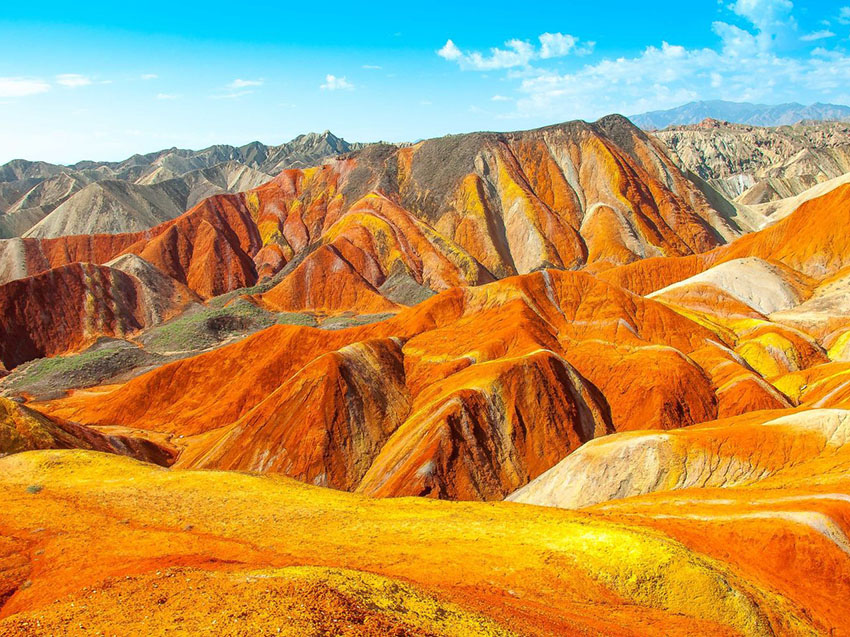 Address: 40km from Zhangye city, Gansu province
Area: 536km2
Climate: temperate zone arid continental monsoon climate
Ticket: 75 RMB/pax
Opening Hours: 7:00 - 18:00 (summertime); 7:30 - 17:00 (winter time)
Recommended visiting hours: 1-5 hours
What to see: colorful mountains, red stones, oddly-shaped landform
Address: 40km from Zhangye city, Gansu province
Area: 536km2
Climate: temperate zone arid continental monsoon climate
Ticket: 75 RMB/pax
Opening Hours: 7:00 - 18:00 (summertime); 7:30 - 17:00 (winter time)
Recommended visiting hours: 1-5 hours
What to see: colorful mountains, red stones, oddly-shaped landform
How was the Zhangye Danxia Landform created?
The development of the Danxia Landform began with the Himalayan orogenetic movements in the late Tertiary Period, which tilted part of the red stratum and raised the red basin to form an outflow area. Then, water began flowing to the lower place in the center and eroded the basin along the rock stratum's vertical structure, forming two deep gullies. When the colluvial deposits on the gullies couldn't be moved by water flow, a colluvial mass with a gentle slope was formed. 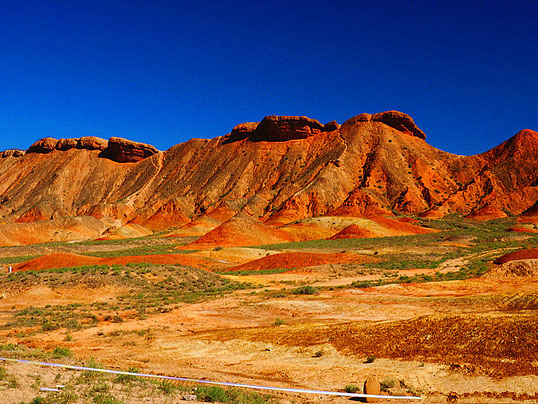 It continued to grow until a slope with the same tilting direction as that of the colluvial mass was formed. The mountain's initial range was gradually reduced, forming fort-like peaks, rock walls, or stone pillars. Then, the erosion furthered and made the peaks, walls, and pillars disappear, only leaving the gentle hills.
The red sandy stratum that contains lots of limestone gravel and calcium carbonate cement, being dissolved by water, became karrens, clints, karst caves, or thin layers of calcium deposits, which later developed into stalactites. The structures that had been deeply eroded by rivers could become square mountains with flat tops or cut into all kinds of oddly-shaped hills. In areas with large rock inclination, monoclinic ridges were formed like rolling dragons. When a large size of stratum collapses along the vertical joints, grand cliff slopes were created. If the cliff slopes develop along the significant joints, tall stone walls emerged, which would be eroded to stone bridges eventually. This is how the magnificent rainbow mountains being created.
It continued to grow until a slope with the same tilting direction as that of the colluvial mass was formed. The mountain's initial range was gradually reduced, forming fort-like peaks, rock walls, or stone pillars. Then, the erosion furthered and made the peaks, walls, and pillars disappear, only leaving the gentle hills.
The red sandy stratum that contains lots of limestone gravel and calcium carbonate cement, being dissolved by water, became karrens, clints, karst caves, or thin layers of calcium deposits, which later developed into stalactites. The structures that had been deeply eroded by rivers could become square mountains with flat tops or cut into all kinds of oddly-shaped hills. In areas with large rock inclination, monoclinic ridges were formed like rolling dragons. When a large size of stratum collapses along the vertical joints, grand cliff slopes were created. If the cliff slopes develop along the significant joints, tall stone walls emerged, which would be eroded to stone bridges eventually. This is how the magnificent rainbow mountains being created.
A Glimpse of Colorful Rainbow Mountains
Zhangye Danxia Rainbow Mountains are the most fantastic place on earth. The light and shadow changes in the mountains are very interesting. 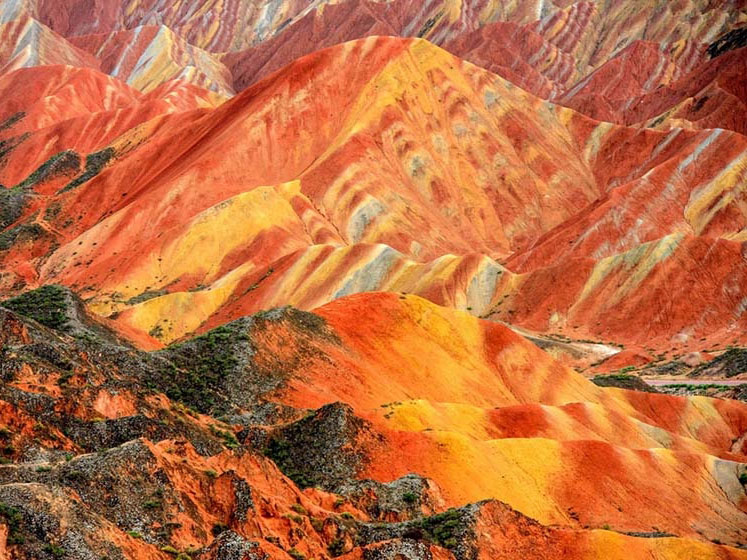 Even if you stand on the same spot, you will still see the different colors at different times. The hills with the same texture also present themselves with different visual effects. Besides, there are more than seven colors. Especially if you shoot pictures right after the rainfall, you will be deeply impressed. Under the different humidity, you can't even capture the same color in the same position and the same angle. The color-changing process is just spectacular.
Relevant chemical analysis tells us that there are hundreds of chemical components in Danxia landforms, and many of the colors can't be observed by the naked eyes. Besides, plenty of Jinshi rocks (a kind of red rock uniquely existed in the Danxia landform) cross-bedded in the stratum also display tons of brilliant colors, which can only be observed by aerial photography. However, visitors are not allowed to use drones to film the majestic mountains. You can only have a paranoma of the rainbow mountains by taking the hot air balloons or powered paragliders.
Even if you stand on the same spot, you will still see the different colors at different times. The hills with the same texture also present themselves with different visual effects. Besides, there are more than seven colors. Especially if you shoot pictures right after the rainfall, you will be deeply impressed. Under the different humidity, you can't even capture the same color in the same position and the same angle. The color-changing process is just spectacular.
Relevant chemical analysis tells us that there are hundreds of chemical components in Danxia landforms, and many of the colors can't be observed by the naked eyes. Besides, plenty of Jinshi rocks (a kind of red rock uniquely existed in the Danxia landform) cross-bedded in the stratum also display tons of brilliant colors, which can only be observed by aerial photography. However, visitors are not allowed to use drones to film the majestic mountains. You can only have a paranoma of the rainbow mountains by taking the hot air balloons or powered paragliders.
How to shoot the best pictures of the Zhangye Rainbow Mountains?
Zhangye Danxia National Geopark is a huge park with five viewing platforms available for you. 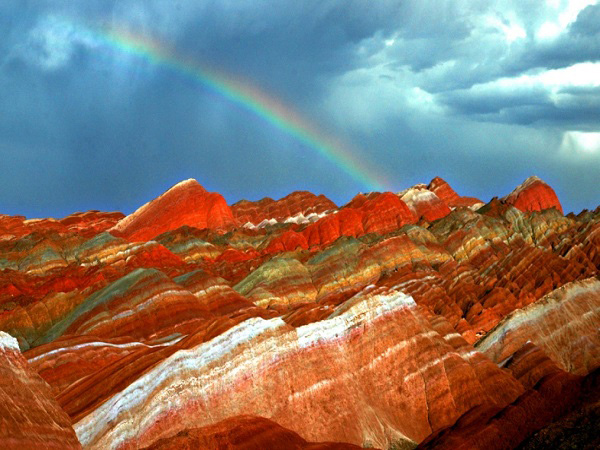 You need to take the shuttle bus between those viewing platforms, and you have to start from the Viewing Platform 1 to 5 successively.
You need to take the shuttle bus between those viewing platforms, and you have to start from the Viewing Platform 1 to 5 successively.
Viewing Platform 1
It’s the largest viewing platform, and to get there, you need to climb a small hill, which only takes about 10 minutes to walk. Your horizon will be wide open once you come to the top and the endless Daxia mountains suddenly surround you. It’s spectacular from every angle. However, the color of the hills is a little faint. Wide-angle lenses tend to capture the best views here. We don’t recommend too much time be spent here.
Viewing Platform 2
The viewing platform 2 is the highest. Standing here, the entire grand Danxia landform is unfolded before your eyes. It’s also 10 minutes’ walk from the viewing platform 1, but you need to cover 666 stairs before reaching the top. You can have a panorama view of the Daxia mountains.
Viewing Platform 3
It’s the place where you can see the world-famous “Seven-color Fan." 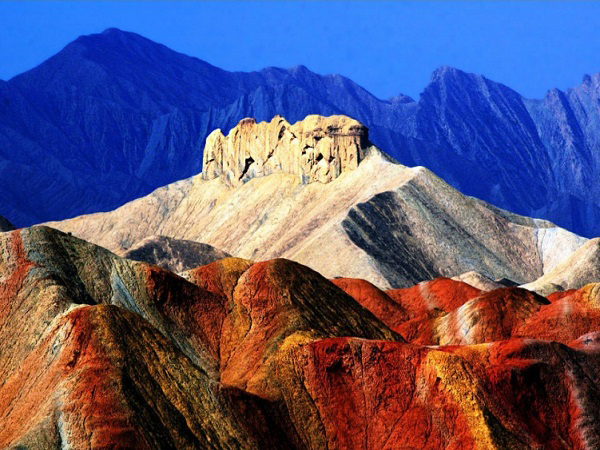 The stairs here are also tainted with three colors harmoniously matching the colors of the mountains. Meanwhile, you can also see the view of "marbled meat," a metaphor to the rainbow mountains' colors here. The mountains will turn to red, orange, and yellow under the sunset, making it perfect for photographing. While in the morning, the colors of the mountains won’t be as bright.
The stairs here are also tainted with three colors harmoniously matching the colors of the mountains. Meanwhile, you can also see the view of "marbled meat," a metaphor to the rainbow mountains' colors here. The mountains will turn to red, orange, and yellow under the sunset, making it perfect for photographing. While in the morning, the colors of the mountains won’t be as bright.
Viewing Platform 4
It’s the main viewing platform. The gentle red waves of mountains and sharp white peaks come to your eyes, giving you a visual feast instantly. It’s a perfect spot to view sunrise and sunset. You can take the overall pictures.
Viewing Platform 5
The view here is similar to Viewing Platform 5, except that you are actually surrounded by brilliant colors now. It’s like you are on an alien planet, desolate but beautiful. It’s a perfect spot to take some close-up photos.
Shooting Tips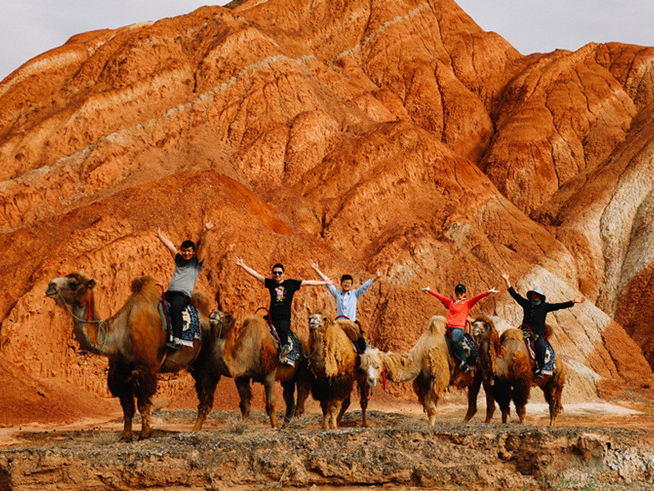
1.The best time to shoot pictures is in the afternoon when the mountains are layering under the sun.
2.It’s best to take pictures after the rainfall, which will make the color of the mountains more striking.
3.Viewing Platforms 1 and 5 are the best spots to take the sunset pictures.
4.Viewing Platform 2 is the best spot to have overall views.
5.Viewing Platform 3 often offers the chance to shoot the mountains in the most bright colors.
Travel Guide to Zhangye Danxia Rainbow Mountains
How to get to Zhangye?
Zhangye is a small city under the jurisdiction of Gansu province. It’s not as convenient as other big cities, but it’s also equipped with airport and train stations that allow you to reach from other Chinese cities.
Zhangye Ganzhou Airport is a semi-military airport. It has regular flights from and back to Xian and Lanzhou, and seasonal flights to and from Urumqi, Chengdu, and Dunhuang. Location: Jichang Road, Ganzhou District, Zhangye, Gansu
Zhangye Railway Station is a relatively small train station that connects Zhangye and Urumqi, Lanzhou, Jiayuguan, Wuwu, and Xian.
Location: No.772, Dongyuan Avenue, Ganzhou District, Zhangye, Gansu
Zhangye West Railway Station is the high-speed train station of Zhangye. It mainly runs back and from to Lanzhou, Jiayuguan, Urumqi, Xian, and Xining.
Location: Between the West Second-ring and Third-ring Roads, Ganzhou District, Zhangye, Gansu
Location: Jichang Road, Ganzhou District, Zhangye, Gansu
Zhangye Railway Station is a relatively small train station that connects Zhangye and Urumqi, Lanzhou, Jiayuguan, Wuwu, and Xian.
Location: No.772, Dongyuan Avenue, Ganzhou District, Zhangye, Gansu
Zhangye West Railway Station is the high-speed train station of Zhangye. It mainly runs back and from to Lanzhou, Jiayuguan, Urumqi, Xian, and Xining.
Location: Between the West Second-ring and Third-ring Roads, Ganzhou District, Zhangye, Gansu
How to get to Danxia National Geopark?
|
Danxia National Geopark
|
Distance
|
Time Need for Driving
|
|
Zhangye West Railway Station
|
50km
|
An hour
|
|
Zhangye Railway Station
|
50km
|
1.5 hours
|
|
Zhangye Ganzhou Airport
|
80km
|
1.5 hours
|
|
Downtown Zhangye (Xiguan Bus Terminal)
|
50km
|
1.5 hours
|
Best Time to visit Zhangye Danxia Landform Geopark?
Summer (June - September) is the best time to visit Zhangye Danxia Landform Geopark. Zhangye is a northwestern city, an ideal place for a summer resort. If you can catch a bright day just after rainfall, you will be rewarded with the most magnificent Danxia landscape. The morning and evening are cool here. You might need a coat. Besides, sun-blocking products are necessities.
Ticket Information
Entrance ticket: 74 RMB/pax.
Sightseeing bus: 20 RMB/pax.
In-depth exploration: 328 RMB/pax.
Tip: if you want to access the park the next day to see the sunrise, you can ask the staff to stamp your ticket for the next day. Then, you won’t be charged the following day again only if you enter the park before eight o’clock.
Recommended Itineraries
8 Days In-depth Silk Road Culture Tour to Dunhuang and Zhangye
15-day Silk Road and Xinjiang Tour
11 days China Silk Road Trip


 It continued to grow until a slope with the same tilting direction as that of the colluvial mass was formed. The mountain's initial range was gradually reduced, forming fort-like peaks, rock walls, or stone pillars. Then, the erosion furthered and made the peaks, walls, and pillars disappear, only leaving the gentle hills.
It continued to grow until a slope with the same tilting direction as that of the colluvial mass was formed. The mountain's initial range was gradually reduced, forming fort-like peaks, rock walls, or stone pillars. Then, the erosion furthered and made the peaks, walls, and pillars disappear, only leaving the gentle hills.  Even if you stand on the same spot, you will still see the different colors at different times. The hills with the same texture also present themselves with different visual effects. Besides, there are more than seven colors. Especially if you shoot pictures right after the rainfall, you will be deeply impressed. Under the different humidity, you can't even capture the same color in the same position and the same angle. The color-changing process is just spectacular.
Even if you stand on the same spot, you will still see the different colors at different times. The hills with the same texture also present themselves with different visual effects. Besides, there are more than seven colors. Especially if you shoot pictures right after the rainfall, you will be deeply impressed. Under the different humidity, you can't even capture the same color in the same position and the same angle. The color-changing process is just spectacular.  You need to take the shuttle bus between those viewing platforms, and you have to start from the Viewing Platform 1 to 5 successively.
You need to take the shuttle bus between those viewing platforms, and you have to start from the Viewing Platform 1 to 5 successively. The stairs here are also tainted with three colors harmoniously matching the colors of the mountains. Meanwhile, you can also see the view of "marbled meat," a metaphor to the rainbow mountains' colors here. The mountains will turn to red, orange, and yellow under the sunset, making it perfect for photographing. While in the morning, the colors of the mountains won’t be as bright.
The stairs here are also tainted with three colors harmoniously matching the colors of the mountains. Meanwhile, you can also see the view of "marbled meat," a metaphor to the rainbow mountains' colors here. The mountains will turn to red, orange, and yellow under the sunset, making it perfect for photographing. While in the morning, the colors of the mountains won’t be as bright.


